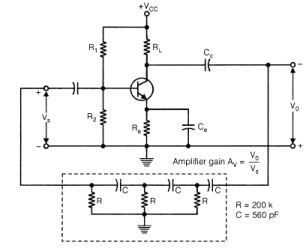Test: Analog & Digital Electronics - 2 - Electrical Engineering (EE) MCQ
20 Questions MCQ Test - Test: Analog & Digital Electronics - 2
An amplifier has an open-loop gain of 100, an input impedance of 10 kΩ and an output impedance of 200 Ω. A feedback factor of 0.99 is connected to the amplifier in a voltage series feedback configuration. The new input and output impedances respectively are
Following shown is an oscillator circuit.

Q.
Which of the following is a correct statement? It is a
Following shown is an oscillator circuit.

Q.
The gain of the amplifier must exceed _____________ to satisfy the conditions of oscillation.
Without feedback, the voltage gain is 40 and distortion is 10%, if feedback factor of -0.01 (negative feedback) is given to the amplifier, the distortion will be
An op-amp is used in the circuit as shown in the below figure. Current l0 is
For the circuit shown in the below figure, the output F will be

Match List-1 (Types of gates) with List-ll (Values of propagation delay) and select
the correct answer-
Codes:
A B C D
The Booiean expression for the output Y in the logic circuit is
Consider the following:
Any combinational circuit can be built using
1. NAND gates
2. NOR gates
3. EX - OR gates
4. Multiplexers
Which of these are correct?
A 3-to-8 decorder is shown below:
All the output lines of the chip will be high, when all the inputs 1,2 and 3
An n-bit A/D converter is required to convert analog input in the range 0 - 5V to an accuracy of 10 mV. The value of n should be
Consider the following statements in respect of ECL gate:
1. Its switching speed is high
2. It provides OR and NOR logic operations
3. Its power dissipation is small as compared to other logic gates
4. Its logic levels are compatible with other logic family gates
Which of these statements are correct?
In the circuit as shown in figure below, assuming initially Q0 = Q1 = 0. Then the states of Q0 and Q1 immediately after the 33rd pulse are
The three-stage Johnson-Ring Counter as shown below is clocked at a constant frequency of fc from the starting state of Q0 Q1Q2 = 1 0 1. The frequency of outputs Q0 Q1 Q2 will be
Which one of the following statements is not correct? Conversion of EXCESS-3 code to BCD can be achieved by using
Match List-1 (Circuit Symbols) with List-ll (Nomenclature) and select the correct answer using the codes given below:
List-1 List-ll
Codes:
A B C D
It is required to construct a 2n-to-1 multiplexer by using 2-to-1 multiplexers only. How many of 2-to-1 multiplexers are needed?
Consider the following circuit:
Which one of the following gives the function implemented by the MUX-based diaital circuit?
Consider the following multiplication: (10w 1z)2 x(15)10 = (y0 10 11 001)2 Which one of the following gives appropriate values of w, y and z?



















